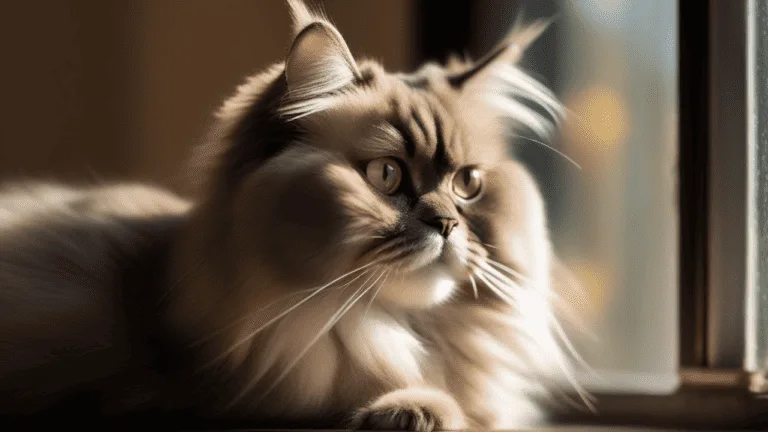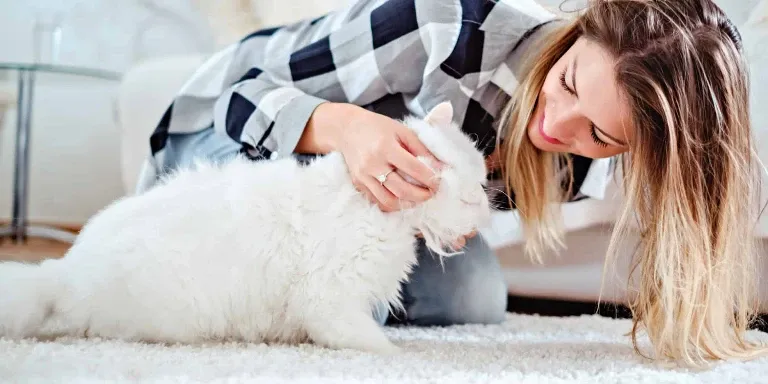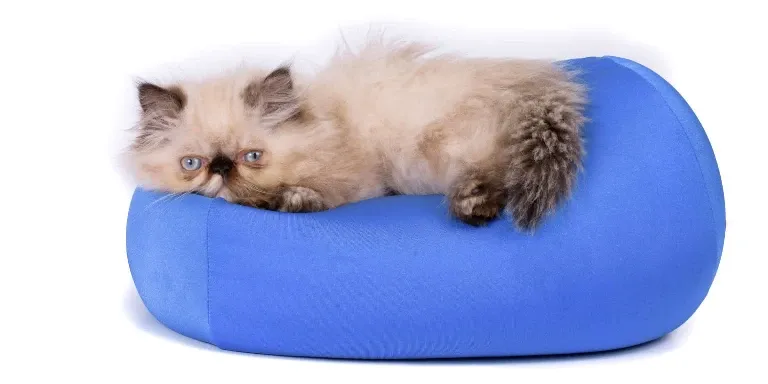The Best Fluffy Pancakes recipe you will fall in love with. Full of tips and tricks to help you make the best pancakes.

Have you ever held a baby? Remember how delicate they felt in your arms, how you had to cradle them just right and support their head? Well, holding a Persian cat is a lot like holding a baby.
While most Persian cats like to be held, it depends on the individual cat. Some enjoy being held and cuddled, while others may not enjoy it as much. It’s important to pay attention to your cat’s body language and behavior to determine if they enjoy being held or not.
These fluffy felines have a reputation for being delicate and sensitive, and many cat owners wonder if their Persian enjoys being held at all. Persian cats are known for their luxurious coats, flat faces, and sweet personalities. They are affectionate, playful, and love attention from their human companions.
But when it comes to being held, every cat is different. Some Persians love to be held and cuddled, while others prefer to keep their distance. In this article, we’ll explore the factors that can affect a Persian cat’s preference for being held, and share some tips for holding your cat properly and introducing them to being held if they’re not used to it.
Understanding Your Persian Cat’s Personality
If you’re wondering if your Persian cat likes to be held, it’s important to understand their unique personality. Persian cats are known for their laid-back and affectionate demeanor. They love to cuddle and be close to their owners, but they also have their own sense of independence.
It’s important to take the time to get to know your Persian cat’s behavior and personality to determine how they feel about being held. Socializing Persian cats is key to understanding their personality. They thrive on attention and love being around their owners, but they can also be timid and shy.
It’s important to create a safe and comfortable environment for your Persian cat, allowing them to feel relaxed and at ease. Slowly introduce them to new situations and people, and make sure to give them plenty of positive reinforcement when they behave well.
Overall, Persian cats are affectionate and loving pets that enjoy being held and cuddled. However, each cat has their own unique personality, so it’s important to take the time to get to know them and understand their behavior. With patience and love, you can create a strong bond with your Persian cat and enjoy many happy moments together.
Factors That Affect a Persian Cat’s Preference for Being Held
As you cradle your fluffy feline, you might notice that some cats enjoy being held more than others, just like how some people prefer hugs while others prefer handshakes.
There are several factors that influence a Persian cat’s preference for being held. These factors include their individual personality, their history of socialization, and their comfort level with physical touch.
One of the most important factors that influence a Persian cat’s preference for being held is their history of socialization. Kittens that are raised in a nurturing and social environment with plenty of human interaction are more likely to develop a positive attitude towards being held. If a Persian cat has not been socialized early on, they may be more prone to fear or anxiety when being held.
Another factor that can influence a Persian cat’s preference for being held is their individual personality. Some cats are naturally more outgoing and affectionate, while others may be more reserved or independent. If your Persian cat is shy or anxious, it may take them some time to feel comfortable being held. It’s important to respect your cat’s boundaries and not force them to do anything that makes them uncomfortable.
Overall, encouraging a positive attitude towards being held in your Persian cat requires patience and understanding. By providing a loving and nurturing environment and respecting your cat’s individual personality, you can help them develop a healthy appreciation for physical touch. Remember, building trust and a strong bond with your feline friend takes time and effort, but the rewards are well worth it in the end.
Tips for Holding Your Persian Cat Properly
To properly hold your fluffy feline friend, it’s important to support their body and provide a sense of security and comfort. Maintaining proper posture is key to ensuring your Persian cat’s comfort. Keep your back straight and your arms close to your body. This prevents any unnecessary strain on your back and shoulders, while also providing support for your cat.
To ensure your Persian cat feels secure, use bonding techniques when holding them. This can include talking in a soothing voice, petting them gently, and providing treats or toys. These actions not only help to build trust and a strong bond between you and your cat, but also provide a sense of familiarity and comfort.
Lastly, it’s important to be mindful of your cat’s body language when holding them. If they begin to squirm or show signs of discomfort, it’s best to gently release them and try again later.
By following these tips, you can properly hold and bond with your fluffy Persian cat, creating a strong and loving relationship.
Introducing Your Persian Cat to Being Held
When introducing your Persian cat to being held, it’s important to start slowly and be patient. Use treats and positive reinforcement to encourage your cat to associate being held with positive experiences.
By taking these steps, you can help your cat become more comfortable with being held and create a stronger bond between the two of you.
Starting Slowly
Gotta admit, easing into holding a Persian cat is like trying to dance the Macarena in stilettos – it’s all about taking it slow. Building trust with your new feline friend is essential when it comes to introducing them to being held.
Persian cats are known to be a bit more reserved and cautious, so a gradual approach is necessary for them to feel comfortable in your arms. Start by offering them treats or toys while sitting close to them. This will help them associate you with positive things and build their confidence around you.
Once they start coming to you on their own, start by gently petting them and gradually incorporating light touches and picking them up for a short period. Over time, they will feel more relaxed and secure in your arms, and you’ll be able to enjoy cuddling with your Persian cat without any issues.
Remember, patience is key when it comes to building a strong bond with your furry friend.
Using Treats and Positive Reinforcement
You can win over your new feline friend by using treats and positive reinforcement to build trust and confidence around you. Using treats is a great way to reward good behavior and encourage positive socialization strategies.
You can start by using a clicker training method to create a positive association between the sound of the clicker and the reward of treats. Positive reinforcement is key when it comes to behavioral conditioning.
Gradual exposure to new situations, people, and handling techniques can help build trust and confidence in your cat. By using gentle handling techniques and trust building exercises, you can help your cat feel more comfortable and confident around you.
It’s also important to pay attention to your cat’s body language and feline communication skills to determine how they are feeling in certain situations. By using these methods, you can create a positive and trusting relationship with your Persian cat.
Alternatives to Holding Your Persian Cat
Although some Persian cats may not enjoy being held, there are other ways to bond with them. Interactive play is a great alternative to holding your Persian cat. They love chasing toys, especially those that mimic prey like feathers or mice. You can also try hiding treats in toys to encourage your cat to play and engage with you.
Another way to bond with your Persian cat is by giving them cozy snuggles. Most Persian cats love to be petted and groomed, so brushing their luxurious fur is a great way to bond with them. Make sure to use a soft brush and gentle strokes to avoid hurting their sensitive skin. You can also try giving them massages or cuddling with them on a soft blanket.
Lastly, spending quality time with your Persian cat is essential for building a strong bond. You can try reading a book or watching TV with your cat by your side. Talking to them in a soothing voice and giving them treats will also help build trust and affection.
Remember, every cat is unique, so it’s essential to pay attention to your cat’s preferences and adjust your interactions accordingly. With patience and love, you can build a strong and meaningful bond with your Persian cat without having to hold them.
Common Mistakes to Avoid When Holding Your Persian Cat
Mistakes can easily be made when holding your beloved Persian feline, so it’s important to be aware of common errors to avoid. Persian cats are sensitive creatures, and if they feel uncomfortable or threatened, they may lash out or become anxious. To avoid any negative reactions, it’s essential to learn proper holding techniques.
- Don’t squeeze or hold your Persian cat too tightly. This can cause discomfort or pain, and your cat will likely try to wiggle free. Instead, gently cradle your cat with one arm supporting their chest and the other supporting their hind legs.
- Avoid holding your Persian cat too high off the ground. This can make them feel insecure and frightened. Keep your cat close to your body and at a comfortable height.
- Never force your cat to be held. If they’re not in the mood for cuddles, respect their boundaries and give them space. Over time, with patience and building trust, your cat may become more comfortable with being held.
- Always make sure your cat feels safe and secure when being held. Speak to them in a soft, soothing voice and avoid any sudden movements that may startle them. Building trust with your cat is crucial, so take the time to get to know their personality and preferences.
By following these tips, you can ensure that holding your Persian cat is a positive and enjoyable experience for both you and your furry friend. Remember to be patient and gentle, and always prioritize your cat’s comfort and well-being. With the right approach, your Persian cat may even start to seek out cuddles and affection on their own.
Addressing Behavioral Issues
If you’re experiencing behavioral issues with your Persian cat, it’s important to address them as soon as possible. Aggression or fearfulness can be signs of underlying health or environmental issues, and should be addressed by a veterinarian or animal behaviorist.
If your cat is resistant to being held, it’s important to understand their body language and respect their boundaries, while also working to build trust and positive associations with being held.
Aggression or Fearfulness
You may notice that your Persian cat becomes aggressive or fearful when held, especially if they’re not used to it or feel uncomfortable in the situation. It’s important to understand that cats have their own personalities and preferences, and some may not enjoy being held or restrained.
It’s important to approach your cat slowly and calmly, and let them approach you on their own terms. This can help build trust and overcome their fear of being held.
If your cat does become aggressive or fearful when held, it’s important to respect their boundaries and avoid forcing them into uncomfortable situations. Work on building their trust through positive reinforcement and gradually introducing them to being held in a safe and controlled environment.
This can help reduce their fear and aggression over time, and make it a more positive experience for both you and your cat. Remember, patience and understanding are key when dealing with any behavioral issues in your cat.
Resistance to Being Held
When trying to hold your Persian feline, it’s essential to approach them slowly and calmly, allowing them to come to you on their terms to build trust and rapport.
Persians are known for their independent nature, and they may resist being held at first. It’s crucial to respect their boundaries and not force them into uncomfortable situations.
Overcoming resistance to being held takes patience and time. Start by offering your cat treats or toys while sitting near them. Gradually move closer and try to pet them gently. If your cat shows signs of discomfort or tries to move away, stop and give them space.
Eventually, your cat may feel comfortable enough to approach you and even jump onto your lap for cuddles. By building trust and positive associations with being held, your Persian feline may become more receptive to physical affection in the future.
Can Holding Persian Cats Affect Their Puberty Development?
Holding persian cats may not affect their puberty age. Persian cats typically reach puberty around 8-12 months. Genetics, diet, and environment play a bigger role. Regular vet check-ups and proper care can ensure healthy development.
Conclusion
In conclusion, understanding your Persian cat’s personality is crucial in determining their preference for being held. While some Persian cats may enjoy being held, others may not be so keen on the idea.
Factors such as their age, past experiences, and current mood can also affect their willingness to be held. If your Persian cat does enjoy being held, it’s important to do so properly. Use gentle and supportive hands, avoid restraining them, and always be aware of their body language.
It’s also important to introduce them to being held gradually and positively to avoid any negative associations. Remember, holding your Persian cat is not the only way to show them affection. Playing with them, grooming them, and simply spending time with them can also strengthen your bond.
As the saying goes, “there’s more than one way to skin a cat.”By understanding your Persian cat’s preferences and needs, you can build a loving and mutually beneficial relationship.








